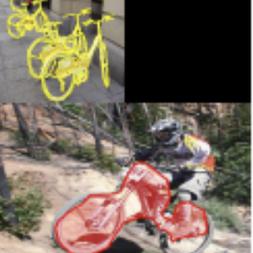One-Shot Segmentation
17 papers with code • 1 benchmarks • 3 datasets
( Image credit: One-Shot Learning for Semantic Segmentation )
Most implemented papers
One-Shot Learning for Semantic Segmentation
Low-shot learning methods for image classification support learning from sparse data.
Image Segmentation Using Text and Image Prompts
After training on an extended version of the PhraseCut dataset, our system generates a binary segmentation map for an image based on a free-text prompt or on an additional image expressing the query.
Self-Supervised One-Shot Learning for Automatic Segmentation of StyleGAN Images
We propose a framework for the automatic one-shot segmentation of synthetic images generated by a StyleGAN.
One-Shot Segmentation in Clutter
We tackle the problem of one-shot segmentation: finding and segmenting a previously unseen object in a cluttered scene based on a single instruction example.
BriNet: Towards Bridging the Intra-class and Inter-class Gaps in One-Shot Segmentation
(2) The object categories at the training and inference stages have no overlap, leaving the inter-class gap.
Contour Transformer Network for One-shot Segmentation of Anatomical Structures
In this work, we present Contour Transformer Network (CTN), a one-shot anatomy segmentation method with a naturally built-in human-in-the-loop mechanism.
Progressive One-shot Human Parsing
In this paper, we devise a novel Progressive One-shot Parsing network (POPNet) to address two critical challenges , i. e., testing bias and small sizes.
End-to-end One-shot Human Parsing
To address three main challenges in OSHP, i. e., small sizes, testing bias, and similar parts, we devise an End-to-end One-shot human Parsing Network (EOP-Net).
One-shot Weakly-Supervised Segmentation in Medical Images
Deep neural networks usually require accurate and a large number of annotations to achieve outstanding performance in medical image segmentation.
Local Spatiotemporal Representation Learning for Longitudinally-consistent Neuroimage Analysis
Recent self-supervised advances in medical computer vision exploit global and local anatomical self-similarity for pretraining prior to downstream tasks such as segmentation.


 Omniglot
Omniglot
 UMD-i Affrodance Dataset
UMD-i Affrodance Dataset
